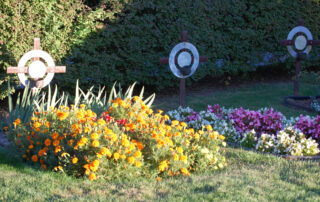 Pillar: Reverence
Pillar: Reverence
Laudato Si’ Action Plan Goals: Ecological Spirituality and Community Engagement
 Pillar: Reverence
Pillar: Reverence
Laudato Si’ Action Plan Goals: Ecological Spirituality and Community Engagement
Group (Grade Levels): 8 years old and up
Learning Goals:
- Foster a sense of eternity/connection with heaven through prayer and reverence for the body in the reality of death.
- Cultivate a little portion (a burial plot) as a way of relationship with those who have died.
Materials Needed: gardening tools, flowers
Estimated Time to Complete Activity: at least 1 1/2 hours
Suggested Time: Eastertime or November (around the Solemnity of All Souls, November 2)
Estimated Number of Sessions if Activity Continues: as desired
Pre-planning: Contact a cemetery near you and arrange plans for the experience
General Outline of Experience
Scripture passage and prayer
- “Amen, amen, I say to you, unless a grain of wheat falls to the ground and dies, it remains just a grain of wheat; but if it dies, it produces much fruit” (Jn 12: 24) OR
- “Joseph of Arimathea, a distinguished member of the council, who was himself awaiting the kingdom of God, came and courageously went to Pilate and asked for the body of Jesus. Pilate was amazed that he was already dead. He summoned the centurion and asked him if Jesus had already died. And when he learned of it from the centurion, he gave the body to Joseph. Having bought a linen cloth, he took him down, wrapped him in the linen cloth and laid him in a tomb that had been hewn out of the rock. Then he rolled a stone against the entrance to the tomb. Mary Magdalene and Mary, the mother of Joses watched where he was laid” (Mark 15: 43-47).
- Like Joseph and the women, we are here to show respect for those who have died. And to pray for them, knowing that Jesus died for the sake of all of us. We pray for those who have died as a spiritual work of mercy, to help them reach heaven to be with God and at peace.
Laudato Si’ brief discussion
Near the end of Laudato Si’, Pope Francis connects caring for creation with heaven. He writes, n. 243-244: “At the end, we will find ourselves face to face with the infinite beauty of God (cf. 1 Cor 13:12) and be able to read with admiration and happiness the mystery of the universe, which with us will share in unending plenitude. Even now we are journeying towards the sabbath of eternity, the new Jerusalem, towards our common home in heaven. . . Eternal life will be a shared experience of awe, in which each creature, resplendently transfigured, will take its rightful place. . . In the meantime, we come together to take charge of this home which has been entrusted to us, knowing that all the good which exists here will be taken up into the heavenly feast.”
How does it change our work on these graves to know that those who have died are waiting for us in heaven?
Concrete opening experience:
Walk around the cemetery and observe the graves for 15 minutes. Adopt someone to pray for. (Ask them to remember the name because they will share it later.)
Once they return, discuss:
- What did you observe? How did you feel? Who are the people you chose to pray for?
- For children, explain that a cemetery is a place where we can connect and continue to show our care concretely; those who have died are with us spiritually. Discuss the reality of eternal life.
- Speak about death, how death entered the world through sin, but through Jesus dying in our place and rising again, our own death brings us to new life. St. Francis expressed this by saying, as the time of his death approached, “Welcome Sister Death.”
- We have reverence for the body always, even in death. The body, though the soul has left it, still represents the person, and it will be re-united with its soul.
- Adults or teens: We show reverence out of respect for what the body has been through and how it has sustained us even when we were not “kind” to our body. (Refer to the fact that St. Francis asked forgiveness from “Brother Ass,” his body, before his death.)
- Adults or teens: Discuss cremation. Why does the Church require that ashes not be scattered?
- Ad resurgendum cum Christo paragraph 5-6, available at https://www.vatican.va/roman_curia/congregations/cfaith/documents/rc_con_cfaith_doc_20160815_ad-resurgendum-cum-christo_en.html. OR
- Catechism of the Catholic Church 2299-2301.
Caring for Graves
- Demonstration of how to use tools, including how to plant flowers.
- Divide participants into pairs or groups and assign group of graves. Remind them to take time and learn about the person, their name, when they lived, etc. What do you learn about the people from their graves?
Gather back after 45 minutes – 1 1/2 hours
Proposed discussion questions:
- Were there distinctive things about the graves (and people) you cared for?
- What does our activity today reveal about what we believe about death and life? Physical death brings us to eternal life. We are connected and can still show love for those who have died.
- Introduce concept of dying to self. Self-denial is part of love. Are there things we need to bury in order to love God and others better?
- Discuss passage from the Life of St. Francis, about welcoming Sister Death.
- In our society we don’t like to face death. Why not?
- Did this experience make you think about your own death? How does that make you feel?
Cross-references to related experiential activities: Garden Work, Restoring Land, Little Portion Experience, Flower-Gazing and Poetry




